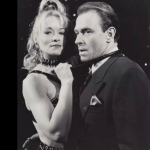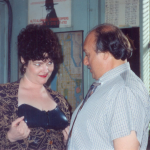IMDB First aired 18 November 1998
DaVinci’s Inquest was a Canadian crime drama that aired from 1998 to 2005. The lead character of coroner Dominic DaVinci is based on real-life Vancouver coroner and later mayor Larry Campbell.
As is typical for this sub-genre, episode S01E07, “The Stranger Within”, begins with the discovery of a dead sex worker. In this case, she’s dumped in a parking lot.
The medical examiner reveals, first, that the victim, Allison Cody, had signs of multiple beatings, which leads DaVinci to suspect sadomasochism. One of the major threads of this episode is the indeterminate cause of her death, which appears to be a pulmonary embolism that might be caused by the bruises from her beatings.

Second, the ME says, “This is one where all is not as it appears to be.” She pulls back the sheet with a flourish, like some 19th century showman with a cabinet of curiosities. She points out that the victim’s jaw is strong and squarish, she has breast implants, her hips are narrow and flat, and she has a “surgically constructed vagina.”
Older cop: “Get the hell out of here.”
DaVinci: “She was a he?”
Younger cop: “Pretty good looking man, hey, Leo?”
ME: “You’re going to have to change the gender on your paperwork.”
From a 2020 perspective, it’s startling just how crude this show is in its treatment of a transwoman (who is dead and can’t speak up for herself). Almost everyone persists in calling Allison “Alan” and uses male pronouns. Her body is treated as a puzzle, something inherently deceptive and even repulsive, with a feminine appearance but a male truth. Even though Allison was post-operative, had been living as a woman for years, and had ID in her post-transition name, it wasn’t enough for these people to respect her gender. The victim’s dead body determines their identity, not the life they lived or how they identified.
We meet only two people who knew Allison when she was alive: her ex-wife, who still seems deeply resentful, and the pro domme she worked with, Mistress Harriet (played by Lisa Howard), who is almost the only person who uses “she” pronouns to talk about Allison.
DaVinci says, “I speak for the dead.” But in this case, he is woefully lacking in empathy for the deceased. And his drive to determine the cause of Allison’s death may only be endangering someone else.
DaVinci tracks down Mistress Harriet and starts pressuring her to tell what happened. Harriet lawyers up and says she has to keep her clients confidential. Eventually he convinces her to meet with him one on one as a private conversation.
Their meeting is set up like a date, in the middle of a busy restaurant. A lot of their conversation has more to do with DaVinci’s curiosity than the case.
DaVinci: “In your opinion, what is it these people want?”
Domme: “Well, it’s not about sex, in most cases.”
DaVinci: “Really?”
Domme: “Yeah. I mean, sometimes it is, but in my experience those are the rare exceptions. If you’re submissive, we call them slaves–”
DaVinci: “Slaves?”
Domme: “Yeah. Then you’re seeking domination, or a release from something.”
DaVinci: “Something you can’t get in your straight life?”
Domme: “Basically, yeah. Sometimes it’s an extension, a very extreme extension, of their personality. They act it out in a safe environment where they’re not judged as freaks, outsiders.”
DaVinci: “So Alan [sic], he [sic] was a submissive.”
Domme: “To a degree. Have a little trouble with this concept?”
DaVinci: “Well, yeah. I don’t get the attraction in slavery.”
Domme: “You’ve never engaged in a submissive act?”
DaVinci: “Excuse me?”
Domme: “Never allowed your partner to dominate you?”
DaVinci: “This isn’t about me. This is about your clients.”
Domme: [gets flirty] “You certainly have something in common with my clients. You’re very secretive about your personal desires.”
The domme later explains on record that Allison had finished a session and was having a cigarette when she just slumped over. Harriet reveals the client who was present, and DaVinci interviews him in private.
The client fits the stereotype of the high-status CEO who submits in the dungeon.
DaVinci: “I’ve been having a lot of difficulty understanding what this activity satisfies. I mean, a man like you, with such a great life. You have people that you care for, you have a position in society that many people would envy.”
Client: “With all that, comes a lot of responsibility, and that comes with a lot of pressure. Some people might take a drink or jump out of an airplane. I don’t know how to explain it. I used to jump on people. I used to hurt them. I don’t do that anymore. I get a release from what I do.”
This leads to another twist: before Allison died, the client beat her, on Mistress Harriet’s orders. This further muddies the waters of the cause of Allison’s death.
After two autopsies came back with “undetermined” cause of death, the case is dropped.
Da Vinci: “That leaves us with a legal act between two consenting adults.
This episode also ends with a dead sex worker. Somebody threw Mistress Harriet out of a window to her death.
This episode has a lot of kinkphobia as well as transphobia. Mistress Harriet is put in a very difficult position between the police and her elite clients. DaVinci in particular goes out of his way to pressure her for no reason other than his own curiosity about BDSM. (He could just get a book out of the library instead.)
The death of Allison ultimately seems to be just an unpredictable accident, which is better than blaming BDSM, but it is entangled in a lot of shame and secrecy. Procedural TV series like Da Vinci’s Inquest are ultimately not a good way to explore minority subcultures, because the narratives revolve around the revelation of truth after the initial lies, and judgement from an outside authority. A police detective or doctor doesn’t interact with BDSM practitioners when things are going fine and everybody is having a good time. They only get involved when somebody is dead.




[…] a hidden truth to be revealed via investigation. This can get into transphobic areas, such as when “reading” a transperson is treated as a triumph of science, not an act of disrespect to the pers…. In this case, the victim’s masochism, revealed by close examination of his physical body, is […]
[…] Much like Lady Heather psychoanalyzing a marriage based on a single still photograph, “Slaves of Las Vegas” takes a snapshot of a very complex situation and throws out a plausible but glib and reductive analysis. This episode shares the same problem of many other procedural episodes on BDSM, including a pretence of scientific objectivity that merely masks a prejudiced and paranoid view. Remember that in a previous episode, CSI featured a lesbian couple who committed murder to avoid being outed (S01E05). Other episodes have treated trans people as deceptive mysteries to unravel. (Not unlike the previously discussed episode of Da Vinci’s Inquest.) […]